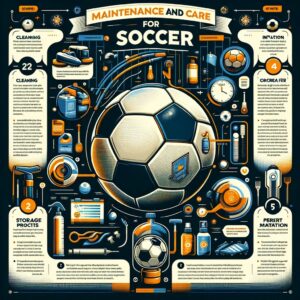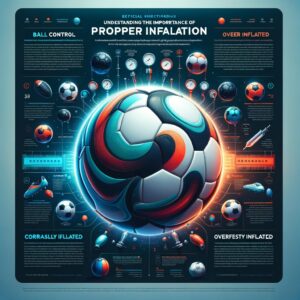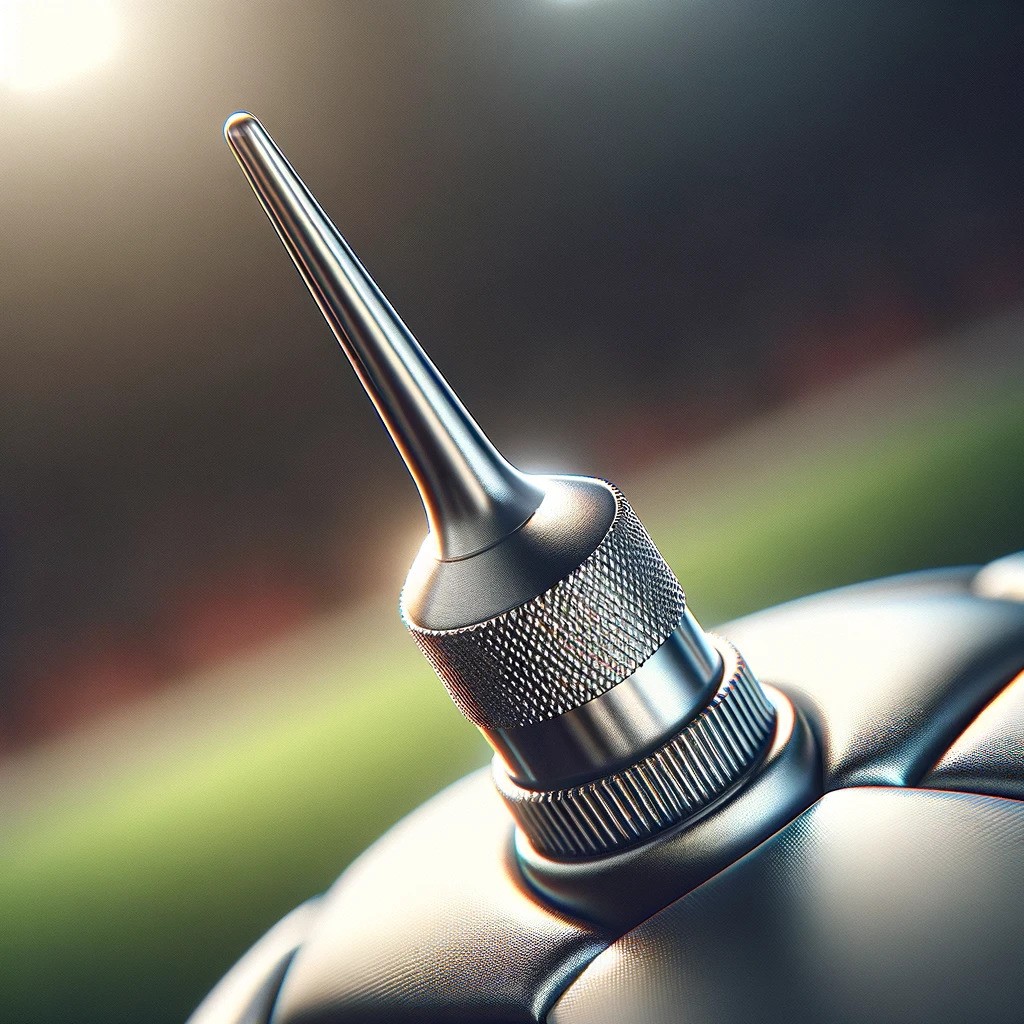In the world of soccer, the ball is arguably the most essential piece of equipment. But to keep the ball in play, one tiny tool plays a crucial role: the soccer ball needle. This seemingly insignificant item is indispensable for inflating soccer balls to the correct pressure, ensuring they’re ready for action. A properly inflated ball can significantly affect the game, impacting everything from the ball’s flight path to how it feels when players strike it.
The soccer ball needle, or inflation needle, is a slender, metal device designed to fit into the ball’s valve, allowing air to be pumped into the ball. Despite its simplicity, choosing the right needle and using it correctly is vital to preserve the lifespan of your soccer ball and maintain optimal playability.
Types of Soccer Ball Needles
There are several types of soccer ball needles available, each suited to different preferences and requirements:
- Standard Metal Needles: These are the most common and widely used. They’re inexpensive and compatible with most pumps. However, they can bend or break if not used carefully.
- Dual-Action Needles: These needles allow air to be pumped into the ball on both the push and pull actions of the pump, making inflation faster and more efficient.
- Pump-Specific Needles: Some air pumps come with proprietary needles designed to fit perfectly with the pump, often providing a more secure fit and reducing the risk of damage to the ball’s valve.
It’s crucial to select a needle that matches your pump and meets your needs, especially if you frequently inflate soccer balls for a team or club. The right needle not only makes inflation easier but also helps prevent damage to the ball.
How to Choose the Right Needle
Choosing the right soccer ball needle involves considering several factors:
- Pump Compatibility: Ensure the needle fits the pump you plan to use. While many needles are universal, some pumps require specific types.
- Material Quality: Look for needles made from durable materials. Stainless steel needles are more resistant to bending and breaking compared to their aluminum counterparts.
- Frequency of Use: If you’re regularly inflating balls for a team or multiple balls for practice, consider investing in higher-quality needles or a bulk pack.
- Ease of Use: Some needles come with features that make them easier to insert and remove, such as a textured grip or a wider base.
Using the correct needle and technique not only extends the life of the needle and the soccer ball but also ensures that the ball performs consistently during play. Always lubricate the needle with a bit of water or saliva before insertion to minimize friction and prevent damage to the ball’s valve. Remember, a little care goes a long way in maintaining the quality of your soccer equipment.
Preparing for Inflation
Necessary Tools
Before inflating a soccer ball, gathering the right tools ensures a smooth and efficient process. Essential tools include a reliable air pump, compatible soccer ball needles, and sometimes a lubricant. The lubricant, which can be as simple as water or saliva, is used to moisten the needle, facilitating easy insertion into the ball’s valve without damaging it.
Some prefer using specialized sports lubricants to minimize friction further and protect the needle and valve. Having a pressure gauge is also critical, either integrated into the pump or as a separate tool, to accurately measure the ball’s pressure and ensure it meets the sport’s regulations.
Step-by-Step Inflation Process
Inflating a soccer ball might seem straightforward, but following the correct steps can prevent damage to the ball and ensure it performs as expected:
- Inspect the Ball and Needle: Before inflation, check the soccer ball for any signs of damage and ensure the needle is straight and undamaged.
- Lubricate the Needle: Apply a small amount of lubricant to the needle. This reduces friction, making it easier to insert into the ball’s valve and reducing the risk of damage.
- Insert the Needle: Carefully insert the lubricated needle into the ball’s valve. It should slide in smoothly without resistance. If you encounter difficulty, do not force it, as this could damage the valve or needle.
- Pump the Ball: Begin pumping air into the ball. Keep an eye on the pressure gauge to fill the ball to its recommended pressure, usually between 8.5 and 15.6 psi, depending on the ball’s size and the manufacturer’s recommendations.
- Remove the Needle: Once the ball is inflated to the correct pressure, carefully remove the needle, taking care not to jerk or bend it.
- Check the Ball: Give the ball a quick inspection and bounce test to ensure it’s properly inflated and ready for use.
This process not only ensures the ball is inflated to the correct pressure but also helps extend the life of both the ball and the needle.
Maintenance and Care

Cleaning the Needle
After each use, it’s important to clean the needle to prevent buildup of dirt and grime, which could lead to difficulties in inserting the needle or even damage the ball’s valve over time. Wipe the needle with a dry cloth after lubrication and inflation. For a deeper clean, especially if the needle was used with a thicker lubricant, use a small amount of rubbing alcohol on the cloth to remove residue. Allow the needle to dry completely before storing.
Storage Tips
Proper storage of soccer ball needles is crucial to ensure they remain in good condition and are easily accessible when needed. Here are some tips for storing your needles:
- Dry Environment: Store needles in a cool, dry place to prevent rust or corrosion, which can weaken the needle or cause it to break.
- Protective Case: If possible, keep needles in a protective case or container to avoid bending or damage from other items.
- Organized and Accessible: Keep needles in a designated spot where they can be easily found, ensuring they’re always ready for use.
Following these guidelines for inflating soccer balls and caring for the equipment will help maintain the quality and longevity of your soccer balls, ensuring they’re always game-ready. Proper maintenance not only prolongs the life of the balls and needles but also ensures the safety and enjoyment of players during the game.
Troubleshooting Common Issues
Needle Won’t Insert
One common issue when inflating a soccer ball is difficulty inserting the needle into the ball’s valve. This problem can occur for several reasons:
- Misalignment or Blockage: The valve may be misaligned or blocked by debris. Gently clean the valve area and realign if necessary.
- Bent Needle: Inspect the needle for any bends. A bent needle can prevent insertion and may need replacement.
- Dry Valve: A dry valve can increase friction, making it hard to insert the needle. Applying a lubricant (water or saliva) can ease insertion.
If these steps don’t resolve the issue, the valve itself may be damaged and require professional repair or ball replacement.
Air Leakage
After inflation, if the ball seems to lose air faster than expected, this could indicate an issue with either the needle or the ball’s valve:
- Faulty Needle: Ensure the needle is not damaged or bent, as this can cause improper inflation and leakage.
- Valve Damage: Over time, the valve may wear out or sustain damage, leading to air leakage. In some cases, using a valve repair kit can solve the problem; however, for severe damage, ball replacement might be necessary.
- Improper Seal: Sometimes, the needle doesn’t form a proper seal with the valve during inflation, leading to air leakage. Ensure the needle is fully inserted and held straight during inflation.
Checking and addressing these points can help resolve air leakage issues, ensuring the ball retains air pressure during play.
Importance of Proper Inflation

Proper inflation is crucial for optimal soccer play. A correctly inflated ball ensures accurate flight, consistent bounce, and reliable control, impacting the overall quality of the game. It reduces the risk of injury, as well, since hitting or heading an over- or under-inflated ball can be harmful. Following the manufacturer’s recommended pressure guidelines ensures the ball performs as designed, contributing to a fair and enjoyable game.
Impact on Game Performance
The inflation level of a soccer ball directly affects its performance on the field. An over-inflated ball may bounce too high and be difficult to control, while an under-inflated ball might not travel as intended, making passes and shots unpredictable. Proper inflation allows players to demonstrate their skills effectively, from precise dribbling to powerful shots, enhancing the overall experience for players and spectators alike.
Conclusion
The importance of the humble soccer ball needle in the broader context of the sport cannot be overstated. It is a small but vital component in ensuring that the game is played with a ball that meets the specific requirements for optimal performance.
Proper care and maintenance of your soccer ball and its accessories, including the needle, not only extend the life of these items but also enhance the overall playing experience. Through understanding the various types of needles, how to select the right one, and the proper techniques for inflation and maintenance, players and coaches can avoid common pitfalls that might otherwise compromise the quality of play.
Frequently Asked Questions
What can I use instead of a ball needle?
In the absence of a traditional ball needle, alternatives such as a straw from a spray can, a thin plastic tube, or a paper clip (straightened and inserted carefully) can be used for emergency inflation. Ensure the makeshift tool fits snugly into the valve to avoid damage.
How do you inflate a soccer ball without a pump and needle?
To inflate a soccer ball without a pump and needle, you can use a balloon. First, inflate the balloon, then use a small nozzle or tube to connect the balloon’s opening to the ball’s valve. Transfer the air by squeezing the balloon. This method requires patience and may not fully inflate the ball to the desired level but can be a temporary solution.
What size thread is a ball needle?
Ball needles typically use a standard size thread that fits most pumps and valves, known as 5/16-32 UNEF (Unified Extra Fine Thread). This size ensures compatibility with a wide range of soccer balls and inflation devices, making them a versatile tool for sports equipment.
What is a ball needle?
A ball needle is a small, slender metal or plastic device designed to fit into the inflation valve of a soccer ball (or other inflatable sports balls) to facilitate the addition of air. It connects to an air pump and allows for precise control of the ball’s air pressure, ensuring optimal performance during play.
How do you deflate a soccer ball without a needle?
To deflate a soccer ball without a needle, you can use a thin, rigid wire (like a paper clip unfolded) or a small straw. Insert it carefully into the valve to open the pathway for air to escape. Apply gentle pressure on the ball to expedite air release. Be cautious to avoid damaging the valve mechanism.
Is there a way to pump a ball without a needle?
Pumping a ball without a traditional needle requires creativity. One method involves using a plastic bottle filled with air. Secure the bottle’s opening tightly against the ball’s valve and squeeze the bottle to force air into the ball. This method may not be as effective as using a needle and pump but can serve as a makeshift solution in a pinch.

